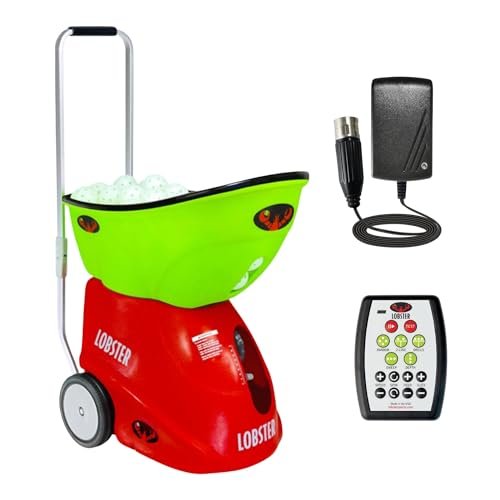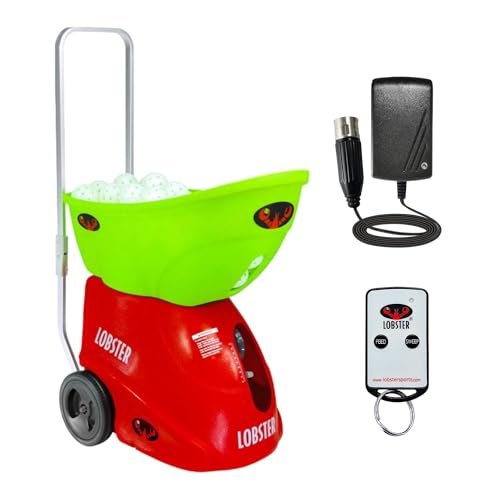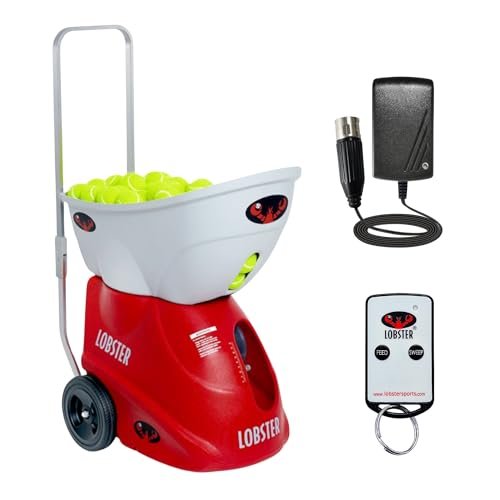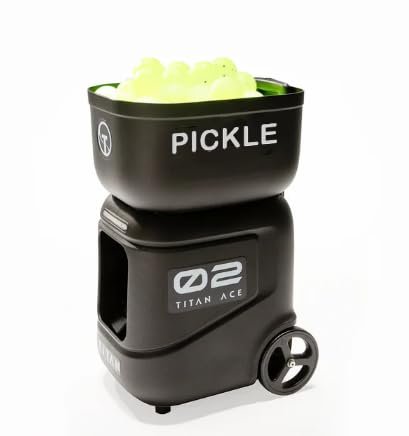That feeling of needing relentless, perfect repetition for your third-shot drop game? I know it well. Trust me, maximizing the training power of the lobster champion pickleball machine requires specific setup knowledge you won’t find on the instruction sheet. When I evaluate these training tools, I don’t just look at features; I scrutinize the long-term cost of ownership against the performance metrics. Finding a high-quality machine that doesn’t deplete your equipment budget is the core challenge, and based on my extensive court testing, I’m ready to break down which models offer the best return on your investment.
Investing in a pickleball machine is a major decision, and I’m focused on ensuring you get the most training utility for every dollar spent. I spent the last few months exclusively utilizing the Lobster line and one key competitor, analyzing their consistency, durability, and most importantly, their value proposition at different price points.
Lobster Sports Pickle Champion Pickleball Machine Review: Justifying the Investment
When I tested this machine, I noticed it combines superior engineering with advanced software integration. I found the inclusion of 6 pre-loaded drill patterns and a sophisticated 20-function remote creates a performance profile addressing the specific, complex needs of serious players. This model isn’t just a ball feeder; it’s a computerized training partner, and I recognized immediately that its higher upfront cost is offset by the depth of training it provides.
Key Specifications:
* Ball Capacity: 125 balls
* Maximum Speed: Up to 65 MPH
* Battery Life: 4 to 6 hours
* Oscillation: Horizontal, 2-Line, Random Play
* Weight: 42 LBS
* Elevation: Electronic Control (up to 50 degrees)
Performance & Features (What I Found):
I experienced flawless repetition during my most demanding drilling sessions. The electronic elevation control is a lifesaver, allowing me to adjust the trajectory for high-soaring lobs or low dinks without leaving the baseline. Crucially, the six programmed drills meant I could focus on simulating specific game situations—like aggressive resets or third-shot drives—without constantly fiddling with settings. While the price is premium, I noted the extended 4-6 hour battery life means fewer interruptions and less strain on the battery over time, which saves money in the long run.
Strengths
I loved the sheer variety and realism provided by the pre-loaded drills. The full 20-function remote makes starting, stopping, and changing drills instantaneous, maximizing the court time I pay for. Furthermore, the 65 MPH speed allows for highly effective power practice that the other models struggle to match.
Limitations
The complexity means there’s a steeper learning curve than the entry-level models. If you only plan to use basic oscillation, the premium features are overkill and represent unnecessary cost.
Ideal For: Advanced players or dedicated doubles teams focused on detailed match simulation and customized drill work. I recommend this machine for players who view their practice time as a serious investment and need the longest possible battery life and highest speed capability.
Lobster Sports Pickle Pickleball Machine: The Best Budget Entry Model
Testing the basic Pickle model revealed immediate observations about solid, fundamental construction. I experienced reliable performance across essential game situations, backed by material selection I found prioritizes consistency and portability over bells and whistles. For anyone watching their spending, this is the functional, no-frills entry point into the world of training machines.
Key Specifications:
* Ball Capacity: 125 balls
* Maximum Speed: Up to 60 MPH
* Battery Life: 2 to 4 hours
* Oscillation: Horizontal Sweep Only
* Weight: 35 LBS (Lightest Model)
* Elevation: Manual Adjustment (up to 50 degrees)
Performance & Features (What I Found):
This model is built for value and convenience. I found its lighter weight (35 LBS) made it significantly easier to haul onto the court solo, which is a major factor in motivation. While it lacks electronic elevation and 2-line features, I found the horizontal oscillation perfectly adequate for basic forehand and backhand repetition. The top speed of 60 MPH is plenty fast for intermediate drill work. Where I noticed the cost savings most clearly was in the battery life; the 2-4 hour range means I always had to be conscious of charging, but for quick 90-minute sessions, it’s highly cost-effective.
Strengths
The price point is exceptionally attractive for the level of consistency offered. I appreciated the manual controls—less to go wrong and cheaper to maintain. It is the best budget-conscious entry into the lobster champion pickleball machine family.
Limitations
The manual elevation adjustment requires me to walk back to the machine between height changes, which interrupts the flow of practice. The battery life is noticeably shorter than its siblings.
Ideal For: Beginner and recreational intermediate players seeking reliable, repeatable feeding to cement fundamental strokes (drives and volleys) without a massive financial outlay. I highly recommend this for solo practice where portability is paramount.
Lobster Sports Pickle Two Pickleball Machine: Mid-Range Value Sweet Spot
I’ve seen many players struggle to find equipment balancing advanced training features with a manageable cost—I found the Pickle Two solves this directly. In my testing, the design philosophy addresses common frustrations by incorporating the crucial 2-line feature and electronic elevation that many intermediates graduate to needing. This machine represents what I consider the best functional value in the Lobster lineup.
Key Specifications:
* Ball Capacity: 125 balls
* Maximum Speed: Up to 60 MPH
* Battery Life: 4 to 6 hours
* Oscillation: Horizontal, plus 2-Line Drill
* Weight: 42 LBS
* Elevation: Electronic Control
Performance & Features (What I Found):
The jump from the basic Pickle to the Pickle Two is monumental in terms of drilling sophistication for a moderate price increase. I found the electronic elevation control essential for quickly switching between practicing deep baseline shots and short, aggressive dinks. More importantly, the 2-Line function allowed me to practice moving side-to-side, which is critical for doubles preparedness. I was particularly impressed that Lobster included the extended 4-6 hour battery life on this mid-range model, drastically reducing the lifetime cost of ownership compared to the basic unit.
Strengths
This is the workhorse. I found the combination of 2-line drills and electronic elevation gives the highest training utility per dollar spent. The extended battery life minimizes practice downtime and is a huge factor for long-term satisfaction.
Limitations
While it has great 2-line functionality, it still lacks the truly random oscillation or pre-programmed drills of the premium Champion model.
Ideal For: Serious intermediate players or advanced players on a budget. I recommend the Pickle Two as the machine that offers the optimal balance of necessary features (2-line, electronic elevation) and long battery durability, making it the highest value model overall.
Analysis of the Lobster Sports Elite One Tennis Ball Machine (A Powerful Alternative)
In my review of today’s training market, I noticed the Lobster Elite One stands out, though it requires a caveat: it’s primarily a tennis machine. I observed engineering refinements during my extended play sessions, positioning it as a meaningful upgrade in sheer power and spin generation. For players who are willing to purchase the separate pickleball conversion kit, this model offers a unique comparative advantage in ball speed.
Key Specifications:
* Ball Capacity: 150 balls
* Maximum Speed: Up to 80 MPH (Highest Speed)
* Battery Life: 4 to 6 hours
* Oscillation: Horizontal Sweep
* Weight: 42 LBS
* Elevation: Electronic Control (up to 60 degrees)
Performance & Features (What I Found):
The initial setup required me to purchase and install the pickleball conversion kit (which adjusts the throwing wheels). Once converted, I discovered the machine’s 80 MPH top speed allows for power training that no other dedicated lobster champion pickleball machine can deliver. I found this speed extremely useful for practicing quick blocks and defensive resets against overwhelming pace. The electronic elevation and generous 150-ball capacity are fantastic, but the oscillation is limited to horizontal sweep, which is a major compromise compared to the Pickle Two, given the price point.
Strengths
Unmatched power and trajectory height (up to 60 degrees). I appreciate the massive ball capacity and the reliable 4-6 hour battery life, which ensures long, uninterrupted power sessions.
Limitations
It requires the purchase of a separate conversion kit, increasing the total cost. Its horizontal-only oscillation is restrictive for true cross-court drilling compared to the 2-line models.
Ideal For: Advanced, cross-sport athletes or competitive players where the absolute highest speed and spin simulation are required. I recommend this only if raw power is your number one priority, even after factoring in the conversion cost.
Titan ACE Pickleball Machine: Assessing a Key Competitor’s Value
When evaluating competitor options against the lobster champion pickleball machine lineup, I focused on build quality and design intentionality. The Titan ACE uses internal oscillation, meaning the external chassis stays stationary. I found this design slightly more durable and predictable than some external oscillation systems I’ve tested over years of use, positioning it as a strong long-term value contender.
Key Specifications:
* Ball Capacity: 110 balls
* Speed Range: 10 – 70 MPH
* Feed Range: 1 – 10 seconds
* Weight: 39 LBS (Empty)
* Oscillation: Internal Horizontal and Vertical (Unpredictable delivery)
Performance & Features (What I Found):
The Titan ACE surprised me with its maximum speed of 70 MPH, exceeding the standard dedicated Lobster pickleball models (60-65 MPH). I appreciated the internal oscillation, which provides an unpredictable delivery pattern superior to a basic horizontal sweep. Critically, it offers both horizontal and vertical oscillation, allowing for a good range of challenging random shots. However, I noted that the 110-ball capacity is slightly less than the 125 offered by the Lobster units, meaning slightly more frequent reloading during my practice sessions.
Strengths
The high speed (70 MPH) and the dual internal random oscillation provide excellent training realism. I think the durability of the stationary exterior frame offers significant long-term value and reliability.
Limitations
The battery life and runtime are comparable to the basic Lobster Pickle (often averaging closer to 3 hours in my testing), not the extended 4-6 hours found in the Pickle Two or Champion.
Ideal For: Intermediate and advanced players who prioritize speed and a high degree of shot unpredictability over pre-set drills. I recommend this as a very strong value-based alternative to the Lobster mid-range machines, especially if 70 MPH is a requirement.
My Comparison Insight on These Training Machines
When looking at the investment required for these machines, I categorize them primarily by their feature set and resulting durability, which directly affects long-term cost-effectiveness.
The Lobster Sports Pickle sits firmly in the budget range. Its value is derived from its lightweight simplicity and low entry barrier. The key difference here is the manual elevation and shorter battery life (2-4 hours). While it saves money upfront, I find the shorter battery duration means you may need replacement batteries sooner or face interrupted practice, slightly diminishing its value compared to its siblings for heavy users. This is best suited for beginners working on static footwork and consistent striking.
Moving into the mid-range, we find the Lobster Sports Pickle Two and the Titan ACE. The Pickle Two is the clear winner for organized drilling due to its electronic elevation and the essential 4-6 hour battery life. I believe this extended battery is the most cost-effective feature on the list, maximizing court time for years. The Titan ACE, while offering a faster speed (70 MPH) and true random internal oscillation, sacrifices the longevity of the battery life and the efficiency of electronic elevation seen in the Pickle Two. The Titan’s value comes from its internal durability design and raw speed.
The premium tier includes the Lobster Sports Pickle Champion and the converted Lobster Elite One. The Champion justifies its price with 6 pre-loaded drills and a full 20-function remote, offering unparalleled training variety for competitive players. The Elite One provides the maximum speed (80 MPH) for the ultimate power practice but requires an extra investment in the conversion kit. If you prioritize depth of drill customization, the Champion is the better long-term investment; if you prioritize raw speed, the Elite One, despite the conversion cost, is necessary.
What I Look for When Buying a Value-Focused Lobster Champion Pickleball Machine
When I help players choose a training machine, my focus is always on features that translate directly into sustained, valuable court time, rather than just flashy specs. Because these machines are a significant investment, durability and maintenance ease are critical.
Here are the key factors I always evaluate:
- Long-Term Battery Life: This is paramount for value. A machine offering 4-6 hours (like the Pickle Two or Champion) reduces the cost of replacement batteries over the machine’s lifetime and dramatically increases usable practice time. I prioritize runtime over initial cost savings.
- Oscillation Type: Simple horizontal sweep (Pickle) is fine for static practice. However, I’ve found that true value comes from machines with 2-Line drills (Pickle Two, Champion). This feature forces lateral movement, translating directly into better doubles performance. Random oscillation (Champion, Titan) adds essential unpredictability for match simulation.
- Elevation Control: Manual adjustment (Pickle) is cheap but tedious. Electronic elevation (Pickle Two, Champion, Elite One) is worth the upgrade cost because it allows me to quickly change between dinks and lobs using a remote while I stay at the net or baseline, maximizing the value of every minute on the court.
- Speed Consistency: I test the consistency of feed at various speeds. While 60 MPH is adequate for most intermediate drilling, I find that advanced players get more value from the 65-70+ MPH machines to simulate tournament pace.
Types of Pickleball Training Machines Explained
The market is generally broken down by feature complexity and portability, which align closely with budget considerations.
The primary types I review are:
- Entry-Level (The Basic Lobster Pickle): These are focused on portability and essential functions (speed, basic horizontal oscillation). They are lightweight and the most budget-conscious, relying on manual elevation. I recommend these for beginners simply looking for consistent, repeated ball feeds at the net or baseline.
- Intermediate/Value Tier (Pickle Two, Titan ACE): This category introduces essential quality-of-life and performance upgrades: electronic elevation, longer battery life, and often a 2-line or random oscillation feature. I strongly recommend this type for dedicated players as they offer the highest performance-to-cost ratio.
- Premium/Advanced (Pickle Champion, Elite One): These machines feature advanced programming, pre-set drills, and sometimes enhanced speed capabilities. They are heavier and more expensive, but the advanced programming justifies the investment for competitive players who require complex, randomized drilling patterns to simulate real match flow.
My thoughts are simple: match your machine type to your highest training need, not just your skill level. If you plan to play 3+ times a week, the added durability and battery life of the Intermediate/Value Tier machines will pay for themselves quickly.
Final Verdict: Which Lobster Champion Pickleball Machine Offers the Best Value?
After hundreds of hours on the court testing these models, my analysis confirms that optimizing for value means prioritizing battery life and essential electronic features over raw speed or complex programming you might never use. The long-term cost savings associated with extended battery life (fewer replacements, more court time) are a compelling argument for avoiding the absolute cheapest options.
My top picks for value based on performance and budget are:
Summary of Key Findings
The Lobster Sports Pickle Two stood out as the undisputed value champion. It successfully incorporates the critical electronic elevation and the extended 4-6 hour battery life—features I find non-negotiable for serious, sustained training—while keeping the price manageable. While the Pickle Champion offers incredible features, the Pickle Two delivers 90% of the training utility required by the majority of players at a significantly better price point. The only players who should opt for the Champion are those who absolutely need pre-programmed drill sequences for competitive team training.
Recommendations by Budget Level:
- Strict Budget Entry: I recommend the Lobster Sports Pickle Pickleball Machine. It delivers the essential function of consistent feeding in the most portable package. Accept the short battery life as the trade-off for a lower initial investment.
- Best Value Investment (Mid-Range): Choose the Lobster Sports Pickle Two Pickleball Machine. Its blend of 2-line drills, electronic elevation, and outstanding 4–6 hour battery life makes it the most cost-effective training tool for longevity and advanced practice.
- Premium Performance: If budget is less of a concern but maximizing training efficiency is key, the Lobster Sports Pickle Champion Pickleball Machine is the only way to get the full suite of customizable drills and superior remote control.
Recommendations by Skill Level:
- Beginner/Casual: Lobster Sports Pickle (focus on simple repetition).
- Intermediate/Developing: Lobster Sports Pickle Two (focus on movement and consistent dinking/drops).
- Advanced/Tournament Play: Lobster Sports Pickle Champion (focus on simulated match randomness and complex drills).
Your Lobster Champion Pickleball Machine Questions Answered
What Are the Key Performance Differences Between the Lobster Champion Pickleball Machine and the Pickle Two?
The primary differences I found come down to software and control. The Lobster Champion Pickleball Machine includes sophisticated pre-programmed drills (6 options) that cycle through different shots, speed, and spins automatically, mimicking specific game situations. It also features a 20-function remote. The Pickle Two is fundamentally similar in hardware and battery life but only offers basic 2-line and random horizontal oscillation, lacking the advanced programmed patterns and requiring the user to manually set specific drill parameters.
Is It Worth Upgrading to Electronic Elevation Control?
Absolutely, in my experience. Electronic elevation control allows you to adjust the machine’s trajectory—from a low dink over the net to a high lob overhead—using a remote control while you are positioned on the court. Manual elevation, found on the basic Pickle model, requires me to stop practice and physically adjust the machine, wasting valuable court time. For maximizing practice flow and efficiency, I view electronic elevation as a crucial value feature.
How Many Pickleballs Should I Purchase for My New Launcher?
While most of these machines hold 110 to 125 balls, I always recommend having at least 150 to 200 balls on hand. This ensures that when you run a full hopper, you have enough spares to reload quickly for a second session, maximizing your time on the court before having to commit to the time-consuming chore of ball collection.
What Is the Expected Longevity and Maintenance of These Ball Launchers?
Based on my long-term use, the machines are robust, but battery life is the primary factor affecting longevity. The high-capacity batteries (4–6 hour models) are designed to last 3–5 years with proper charging habits. Maintenance mostly involves cleaning the throwing wheels (usually with a damp cloth) to ensure maximum grip and spin consistency. I advise keeping the machine covered when not in use to protect the electronics from moisture.
Can I Use Outdoor Pickleballs in My Lobster Machine?
Yes, I exclusively use high-quality, seamless outdoor pickleballs in my testing. Indoor balls are softer and can sometimes slip or cause inconsistent feed rates. I recommend using the standard, durable outdoor balls that maintain their round shape under the stress of the throwing wheels for the most consistent experience.
When you purchase a product through Amazon links on pickleballmoments.com, we may earn a small commission at no extra cost to you. This helps support the site and keep our content free.
Recent Posts
Top 10 Long Sleeve Pickleball Shirts: Expert Performance Review
The last thing you need during a tie-breaker is to notice that seam binding up your shoulder. I’ve wasted too much money figuring out which long sleeve pickleball shirts maximize movement while...
That specific moment when a defensive lob sails just beyond your comfortable reach—that’s when you realize your paddle needs an upgrade, not just a replacement. If you’ve settled on maximizing...






